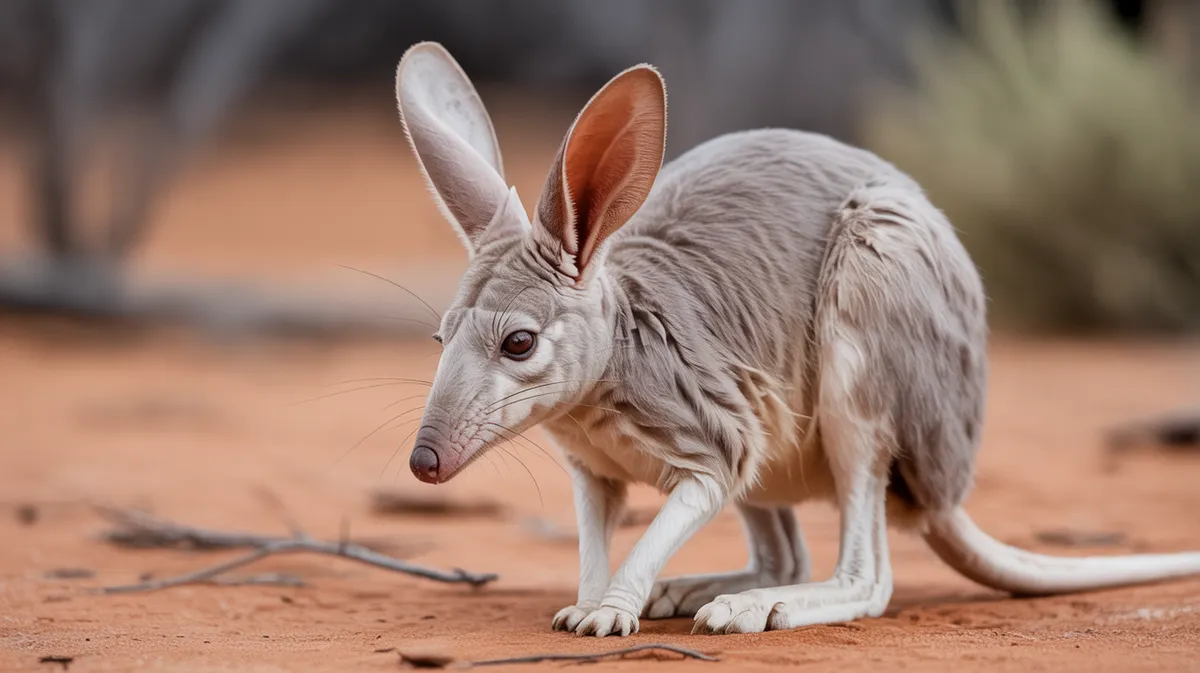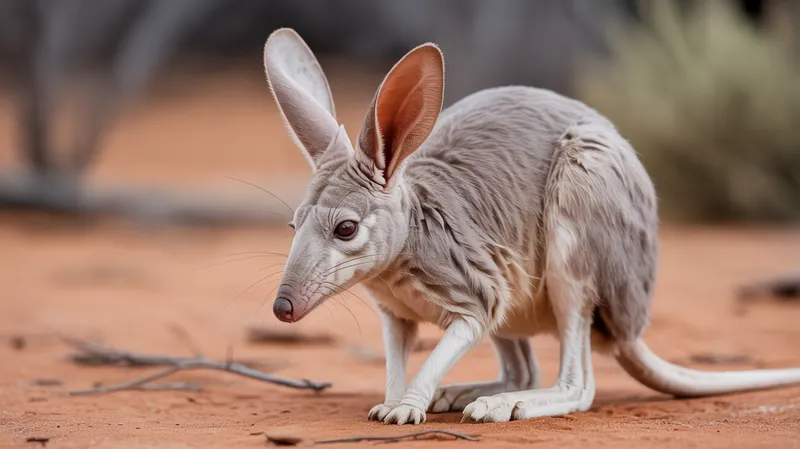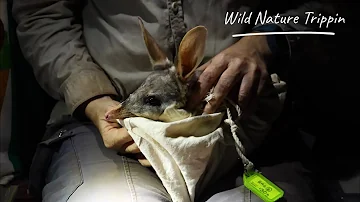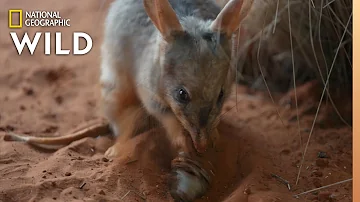
Greater Bilby
Macrotis lagotis

Meet the Greater Bilby
The Greater Bilby is a nocturnal, burrowing marsupial native to arid regions of Australia. Recognizable by its long, silky blue-grey fur, large ears, and pointed snout, the bilby is well-adapted for life in the desert. It uses its strong forelimbs and claws to dig extensive burrow systems that provide shelter from predators and extreme temperatures. The bilby is an important ecosystem engineer, as its digging helps aerate the soil and facilitate seed dispersal. Once widespread, the bilby now occupies only a fraction of its former range due to habitat loss and predation by introduced species.
Classification
Mammal
Habitat
Arid and semi-arid desert regions
Diet
Omnivore
Lifespan
6-7 years in the wild
Conservation
Vulnerable
Weight
0.8-2.5 kg
📖Fascinating Facts
Master Diggers
Bilbies can dig up to 12 burrows within their home range, using them for shelter and protection from the harsh desert environment.
Nocturnal Lifestyle
Greater Bilbies are strictly nocturnal, foraging at night for insects, seeds, bulbs, and fungi to avoid daytime heat.
Superb Hearing
Their oversized ears not only improve hearing but also help dissipate heat, a crucial adaptation in their arid habitat.
📋Detailed Description
The Greater Bilby (Macrotis lagotis) is a medium-sized marsupial, with adults typically weighing between 0.8 and 2.5 kilograms and measuring 29–55 cm in body length, with an additional 20–29 cm tail. Its most distinctive features are its elongated, rabbit-like ears, which enhance its acute sense of hearing and help dissipate heat. The bilby’s fur is soft and silky, colored pale blue-grey above and white below, providing camouflage in sandy environments. Its long, pointed snout is highly mobile and sensitive, aiding in the detection of subterranean prey. Bilbies possess strong forelimbs with well-developed claws for efficient burrowing; they construct complex tunnel systems up to 3 meters long and 2 meters deep. These burrows offer protection from predators and extreme desert temperatures. The species is largely solitary, with overlapping home ranges but little direct social interaction outside the breeding season. Bilbies are nocturnal, emerging at dusk to forage and returning to their burrows before sunrise. Their diet is highly varied, including insects, larvae, seeds, bulbs, fruit, and fungi, reflecting their omnivorous and opportunistic feeding habits. As ecosystem engineers, their digging activities significantly enhance soil turnover and nutrient cycling, benefiting a wide range of other desert organisms.
💡 Did you know?
The Greater Bilby is sometimes called the 'Easter Bilby' in Australia, where it serves as a conservation-friendly alternative to the Easter Bunny.
🔬Research & Sources
Wikipedia Summary
The greater bilby, or simply the bilby, is a long-eared, rabbit-like mammal native to Australia. It lives in burrows and is active at night, feeding on insects, fruit, or fungi. The bilby is a marsupial and carries its young in a pouch. Threats include habitat loss, disease, and introduced predators such as foxes. Formerly widespread, bilbies are now restricted to arid parts of northwestern and central Australia.
Last Modified: 5/22/2025
🎭Behavior & Social Structure
Greater Bilbies are primarily solitary and nocturnal, spending daylight hours in their burrows to avoid heat and predation. They emerge at night to forage, using their keen sense of smell and hearing to locate food. Foraging behavior is characterized by rapid, purposeful digging and probing with the snout. Bilbies are opportunistic feeders, shifting their diet seasonally based on food availability; during dry periods, they rely more on bulbs and seeds, while invertebrates and fungi are consumed when abundant. They are generally non-territorial, with home ranges that can overlap, especially between males and females. Social interactions are limited, mostly occurring during the breeding season or when mothers care for their young. Bilbies use scent marking to communicate and may vocalize with soft grunts or squeaks. They are known for their agility and speed, which help them evade predators.
👶Reproduction & Life Cycle
Breeding in Greater Bilbies can occur year-round in captivity, but in the wild, it is often linked to periods of increased food availability, typically following rainfall. Females are polyoestrous and can produce up to four litters per year under optimal conditions. Gestation is short, lasting only about 12–14 days—the shortest among mammals—after which one to three tiny, underdeveloped young crawl into the mother’s backward-facing pouch. The pouch protects the young from dirt while the mother digs. Pouch life lasts approximately 75 days, after which the young remain in the burrow for several weeks before becoming fully independent. Females reach sexual maturity at around six months, while males mature slightly later. Parental care is provided solely by the mother, with no involvement from the male.
🛡️Adaptations & Survival
The Greater Bilby exhibits numerous adaptations for arid environments. Its large ears not only provide acute hearing but also serve as radiators to dissipate excess body heat. The backward-opening pouch prevents sand from entering while burrowing. Bilbies have a low metabolic rate and can survive without free-standing water, deriving moisture from their food. Their fur coloration provides effective camouflage against sandy and stony desert backgrounds. The species’ strong forelimbs and claws are specialized for rapid digging, both for foraging and creating extensive burrow systems. Bilbies are also capable of rapid reproduction, allowing populations to recover quickly after favorable environmental conditions.
📚Research Sources
🎨Cultural Significance
The Greater Bilby holds significant cultural value for many Indigenous Australian groups, featuring in traditional stories and Dreamtime mythology as a symbol of cleverness and resourcefulness. In contemporary Australian culture, the bilby has become an emblem of wildlife conservation. The 'Easter Bilby' campaign, which promotes chocolate bilbies instead of rabbits, raises awareness about the threats posed by introduced species and supports conservation funding. Bilbies are also used as flagship species in education and outreach programs, highlighting the importance of protecting Australia’s unique arid-zone fauna.
🔬Recent Research & Discoveries
Recent research has focused on the ecological role of bilbies as ecosystem engineers, demonstrating their positive impact on soil health and plant diversity through digging and foraging activities. Genetic studies have revealed low genetic diversity in some isolated populations, emphasizing the need for managed gene flow in conservation programs. Ongoing reintroduction projects, such as those in predator-free reserves in Western Australia, Queensland, and South Australia, are being closely monitored to assess population viability and behavioral adaptation. Studies on bilby diet using DNA metabarcoding have provided new insights into their foraging ecology and the importance of fungi in their diet. Advances in radio-tracking and camera trapping have improved understanding of bilby movement patterns and habitat use.
🎥Wildlife Videos

Bilby - 5 Minute Documentary
Step into the enchanting world of the bilby with a delightful five-minute documentary that introduces you to this elusive and ...
Five Minute Documentaries

Bilby conservation to save the Greater Bilby. Ep.11 + Pelican breeding colony spectacle!
Of all the wildlife research and programs that we've been lucky enough to assist with, this one carry's some serious weight.
Wild Nature Trippin

Meet The Bilby of Taronga Zoo | Secrets of the Zoo: Down Under
About National Geographic Wild: National Geographic Wild is a place for all things animals and for animal-lovers alike. Take a ...
Nat Geo Animals

Greater Bilby Footage
FOOTAGE Royalty Free for Sale in 4K, HD or other formats/media. Also available as individual clips. The list of edited clips is on ...
Carlo Ferraro

Australia’s Wild Northeast | Wildlife Documentary 4K | Queensland Animals and Landscapes
Embark on a captivating journey through the diverse landscapes of Queensland, Australia's northeastern state. From the ancient ...
Into the Wild Films

Secrets of the Outback | Wild Australia in 4K | Wildlife Nature Documentary
To many, Australia's Outback seems barren and inhospitable — a vast, sun-scorched wilderness with little life to offer. But look ...
Into the Wild Films
🌍Habitat Information
The Greater Bilby typically inhabits Arid and semi-arid desert regions environments. Greater Bilbys have adapted to their environments with specialized features and behaviors.
Primary Habitat:
Arid and semi-arid desert regions
More detailed habitat information will be available soon.
🛡️Conservation Status
The Greater Bilby is currently classified as Vulnerable. Conservation efforts are crucial for preserving this species for future generations.
Common Threats:
- 🏠Habitat loss and fragmentation
- 🌡️Climate change impacts
- 🎯Hunting and poaching
- 🏭Human-wildlife conflict
⚠️Threats & Conservation Challenges
The primary threats to Greater Bilbies are habitat loss due to agricultural expansion, altered fire regimes, and competition with introduced herbivores such as rabbits and livestock. Predation by introduced species—particularly red foxes (Vulpes vulpes) and feral cats (Felis catus)—has caused severe population declines and local extinctions. Fragmentation of populations has increased vulnerability to stochastic events and reduced genetic diversity. Disease and climate change, leading to more frequent droughts, further threaten their survival. Conservation efforts include predator control, habitat restoration, and reintroduction programs in predator-proof reserves. Despite these efforts, the wild population remains fragmented and vulnerable, with an estimated total population of fewer than 10,000 mature individuals.
🔬Scientific Classification
Scientific Name
Macrotis lagotis
Classification Hierarchy
🔍 About Taxonomic Classification
Taxonomic classification is a hierarchical system used by scientists to classify and organize living organisms based on shared characteristics and evolutionary relationships.
The system moves from broad categories (Kingdom) to increasingly specific ones, with each animal's scientific name typically consisting of its Genus and species.
📝Community Notes
Share your observations and insights about the Greater Bilby with our community of wildlife enthusiasts.
Join Our Community
Sign in to share your observations and connect with fellow wildlife enthusiasts.
Sign In to ContributeNo community notes yet
Be the first to share your observations about the Greater Bilby!
Explore Greater Bilby
Select a tab above to learn more about this amazing animal.
📸Photo Gallery
No photos available for this animal yet.
🌟Discover More Wildlife
Continue your journey of discovery with more fascinating animals from our database
